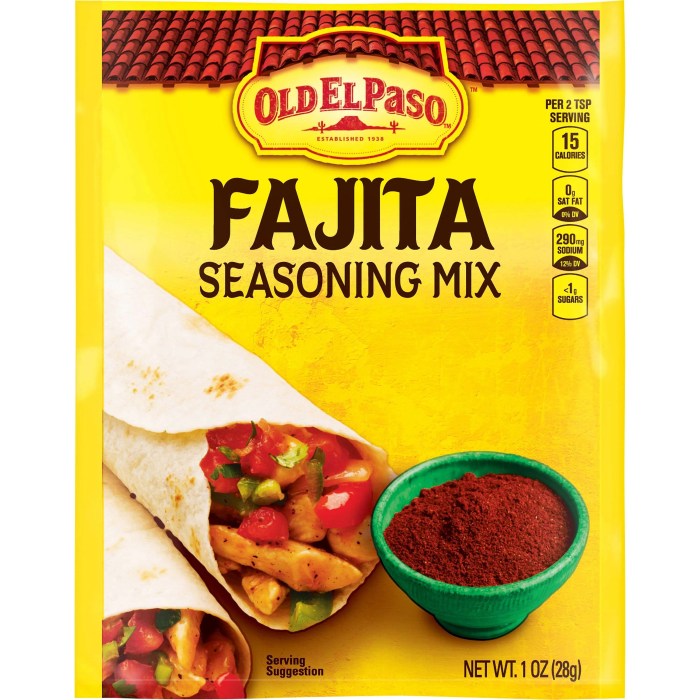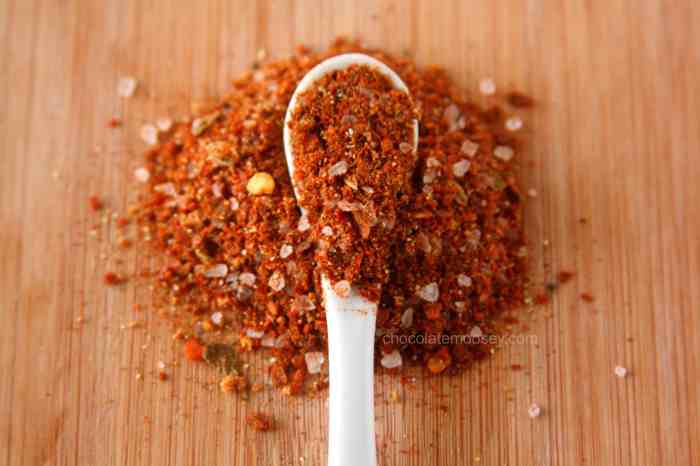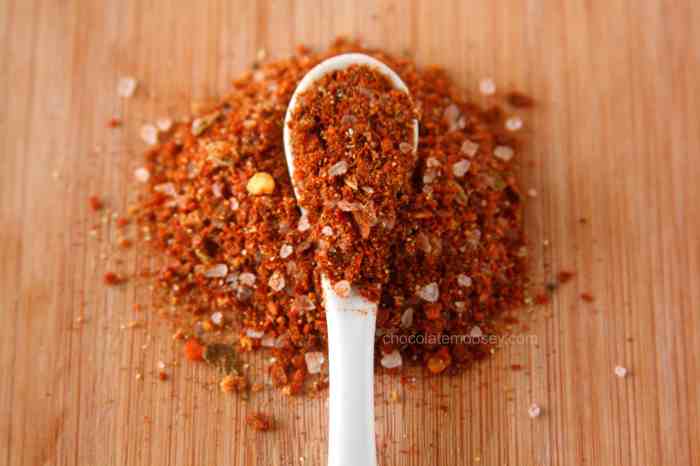DIY Fajitas Seasoning: Tired of the same old store-bought fajitas seasoning? Embrace the freedom of creating your own unique blend, where you control the flavor and spice levels to perfectly match your taste. Forget about generic mixes, it’s time to unleash your culinary creativity and craft a fajitas seasoning that’s as individual as you are.
This guide will walk you through the essential ingredients, blending techniques, and flavor variations to help you create the ultimate fajitas seasoning. From smoky and spicy to citrusy and bright, the possibilities are endless. Get ready to elevate your fajitas to new heights with a personalized seasoning that’s sure to impress.
The Allure of DIY Fajitas Seasoning
The appeal of crafting your own fajitas seasoning lies in the ability to personalize your flavor profile and take control of the ingredients. Unlike store-bought options, which often contain hidden additives or ingredients you may not prefer, making your own seasoning allows you to tailor it to your exact taste.
Customization and Control Over Ingredients
Crafting your own fajitas seasoning gives you the freedom to choose the specific ingredients and their proportions, resulting in a truly unique blend. You can adjust the levels of spice, salt, and other flavor components to suit your preferences.
“Creating your own seasoning allows you to control the quality and freshness of the ingredients.”
For instance, you can experiment with different types of chili powder, cumin, paprika, and garlic powder to create a blend that perfectly complements your favorite fajita recipe. Additionally, you can incorporate other herbs and spices like oregano, cilantro, or even a touch of smoked paprika for a more complex flavor profile.
Essential Ingredients for a Flavorful Fajitas Seasoning
A good fajita seasoning is a blend of spices that creates a complex and flavorful profile, enhancing the taste of the meat and vegetables. The right combination of ingredients is crucial for achieving that authentic fajita flavor.
The following are essential ingredients typically found in fajitas seasoning:
Core Ingredients and Their Roles
Here’s a breakdown of the core ingredients and their roles in creating the characteristic fajita flavor:
- Chili Powder: This is the foundation of fajita seasoning, providing a smoky, earthy, and slightly spicy flavor. Chili powder is typically a blend of dried chiles, including ancho, guajillo, and pasilla.
- Cumin: Cumin adds a warm, earthy, and slightly bitter flavor that complements the chili powder. It also provides a subtle hint of nuttiness.
- Garlic Powder: Garlic powder contributes a pungent, savory flavor that adds depth and complexity to the seasoning.
- Onion Powder: Onion powder adds a sweet and savory flavor that balances the spiciness of the chili powder and cumin.
- Paprika: Paprika adds a mild, sweet, and slightly smoky flavor, adding another layer of depth to the seasoning.
- Salt: Salt is essential for enhancing the flavors of the other ingredients and balancing the overall taste.
- Black Pepper: Black pepper adds a touch of heat and sharpness, rounding out the flavor profile.
- Oregano: Oregano provides a slightly bitter and earthy flavor, adding a touch of Mediterranean flair.
Ingredient Substitutions for Dietary Restrictions
For those with dietary restrictions or preferences, here are some substitutions for the core ingredients:
| Ingredient | Substitution | Reason |
|---|---|---|
| Chili Powder | Smoked Paprika | Provides a smoky flavor without the heat |
| Garlic Powder | Fresh Garlic | Provides a stronger garlic flavor |
| Onion Powder | Fresh Onion | Provides a sweeter and more pronounced onion flavor |
| Salt | Sea Salt, Himalayan Salt | Alternative salt options for those with dietary restrictions |
Fajitas Seasoning Variations

Fajitas seasoning is a versatile blend that can be customized to create different flavor profiles, ranging from smoky and spicy to citrusy and tangy. Experimenting with various spices and herbs allows you to personalize your fajitas and create unique culinary experiences.
Flavor Profiles and Ingredient Combinations
Different flavor profiles can be achieved by adjusting the proportions of spices and herbs. The following table showcases specific ingredient combinations for each flavor profile:
| Flavor Profile | Ingredients |
|---|---|
| Smoky | Paprika, cumin, chili powder, garlic powder, onion powder, smoked paprika, chipotle powder |
| Spicy | Paprika, cumin, chili powder, garlic powder, onion powder, cayenne pepper, red pepper flakes |
| Citrusy | Paprika, cumin, chili powder, garlic powder, onion powder, orange zest, lime zest, cilantro |
Unique and Creative Fajitas Seasoning Blends
Beyond the traditional flavors, you can create unique and creative fajitas seasoning blends by incorporating unusual ingredients. Here are some recipe ideas:
Citrus-Ginger Fajitas Seasoning
– 2 tablespoons paprika
– 1 tablespoon cumin
– 1 tablespoon chili powder
– 1 tablespoon garlic powder
– 1 tablespoon onion powder
– 1 tablespoon ginger powder
– 1 tablespoon orange zest
– 1 tablespoon lime zest
– 1 tablespoon cilantro
Chipotle-Lime Fajitas Seasoning
– 2 tablespoons paprika
– 1 tablespoon cumin
– 1 tablespoon chili powder
– 1 tablespoon garlic powder
– 1 tablespoon onion powder
– 1 tablespoon chipotle powder
– 1 tablespoon lime zest
– 1 teaspoon black pepper
Cajun-Style Fajitas Seasoning
– 2 tablespoons paprika
– 1 tablespoon cumin
– 1 tablespoon chili powder
– 1 tablespoon garlic powder
– 1 tablespoon onion powder
– 1 tablespoon cayenne pepper
– 1 tablespoon dried oregano
– 1 tablespoon thyme
Beyond the Seasoning

While your homemade fajita seasoning is the star of the show, it’s just one piece of the puzzle for a truly delicious fajita experience. To elevate your meal, you’ll need to consider the other essential ingredients and techniques that contribute to a flavorful and satisfying fajita feast.
Meat Selection and Marinating
Choosing the right cut of meat is crucial for tender and flavorful fajitas. Skirt steak, flank steak, and chicken breasts are popular choices, each offering unique textures and flavors. Marinating the meat is a key step that infuses it with additional flavor and helps to tenderize it.
- Skirt Steak: This cut is known for its rich flavor and tenderness, but it can be a bit tough if not cooked properly. Marinating helps to break down the tough fibers and enhance its natural flavor.
- Flank Steak: Similar to skirt steak, flank steak is flavorful but can be chewy. Marinating helps to tenderize the meat and make it more enjoyable to eat.
- Chicken Breasts: Chicken breasts are a lean and versatile option for fajitas. Marinating helps to infuse them with flavor and keep them moist during cooking.
Marinades can be as simple as a mixture of olive oil, lime juice, and your homemade fajita seasoning, or more complex with the addition of garlic, onions, and other spices. Allow the meat to marinate for at least 30 minutes, or up to 24 hours for optimal flavor.
Grilling or Pan-Frying Techniques
The cooking method you choose will significantly impact the final result of your fajitas. Grilling offers a smoky char and a crispy exterior, while pan-frying provides a quick and easy way to cook the meat.
- Grilling: Preheat your grill to medium-high heat. Grill the marinated meat for 2-3 minutes per side, or until cooked to your desired doneness. Be sure to sear the meat well to achieve a flavorful crust.
- Pan-Frying: Heat a large skillet over medium-high heat. Add a tablespoon of oil to the skillet and sear the marinated meat for 2-3 minutes per side, or until cooked through. For a crispier exterior, you can add a tablespoon of butter to the skillet during the last minute of cooking.
Additional Fajita Essentials
Beyond the seasoning and meat, there are several other essential ingredients that complete the fajita experience.
- Onions and Bell Peppers: These vegetables are a staple in fajitas, adding sweetness, color, and texture to the meal. Slice them thinly and grill or pan-fry them alongside the meat.
- Tortillas: Warm tortillas are essential for wrapping the fajita fillings. Flour tortillas are a popular choice, but corn tortillas can also be used.
- Toppings: Fajitas are a blank canvas for creativity, so feel free to add your favorite toppings. Popular options include guacamole, salsa, sour cream, cheese, and cilantro.
Storage and Shelf Life
Proper storage is crucial for preserving the freshness and flavor of your homemade fajitas seasoning. By following a few simple guidelines, you can ensure that your seasoning stays vibrant and delicious for an extended period.
Storage Recommendations, Diy fajitas seasoning
To maximize the shelf life and retain the optimal flavor of your homemade fajitas seasoning, follow these storage recommendations:
- Airtight Container: Store your seasoning in an airtight container, such as a glass jar with a tight-fitting lid. This prevents moisture and air from penetrating, which can lead to clumping and flavor degradation.
- Cool and Dry Place: Keep the container in a cool and dry location, away from direct sunlight and heat sources. A pantry or cupboard is an ideal spot for storing your seasoning.
- Labeling: Label the container with the date of preparation. This helps you keep track of the seasoning’s freshness and ensures you use the oldest batches first.
Shelf Life
Homemade fajitas seasoning, when stored correctly, typically has a shelf life of 6 to 12 months. The exact duration can vary depending on the specific ingredients used and the storage conditions. However, with proper storage, you can enjoy the vibrant flavors of your seasoning for a significant period.
Preserving Flavor and Aroma
Here are some additional tips for preserving the flavor and aroma of your homemade fajitas seasoning over time:
- Avoid Moisture: Moisture is the primary enemy of spice blends. Ensure your seasoning is completely dry before storing it to prevent clumping and flavor loss.
- Whole Spices: If you’re using whole spices, consider grinding them fresh just before using them in your seasoning. This helps retain the maximum aroma and flavor.
- Small Batches: If you’re concerned about the seasoning losing its freshness, consider preparing smaller batches that you can use within a shorter timeframe.
Crafting your own fajitas seasoning is a journey of culinary exploration, allowing you to customize flavors and create a blend that perfectly suits your palate. Whether you’re a seasoned cook or just starting out, this guide provides a roadmap to mastering the art of fajitas seasoning. So, gather your favorite spices, unleash your creativity, and enjoy the satisfaction of creating a truly delicious and unique seasoning that will transform your fajitas into a culinary masterpiece.
Creating your own fajita seasoning is a great way to customize your Mexican-inspired dishes. If you’re looking for a way to add some spice to your meals, consider building a diy chicken perch for your backyard. Once you’ve got your chicken cooked to perfection, toss it in your homemade fajita seasoning for a flavorful and satisfying meal.

